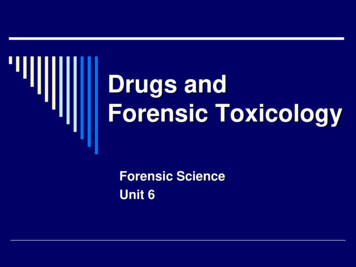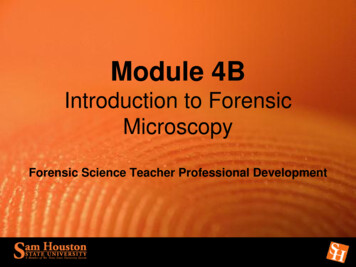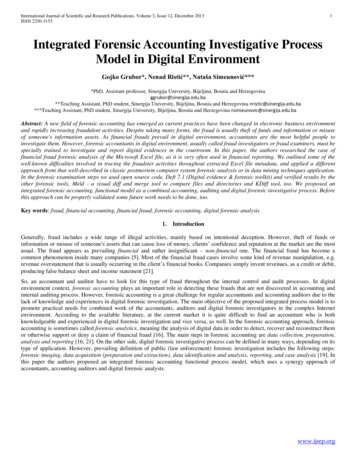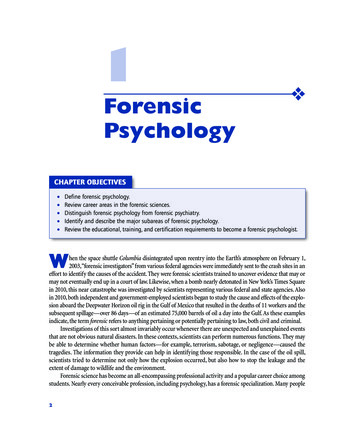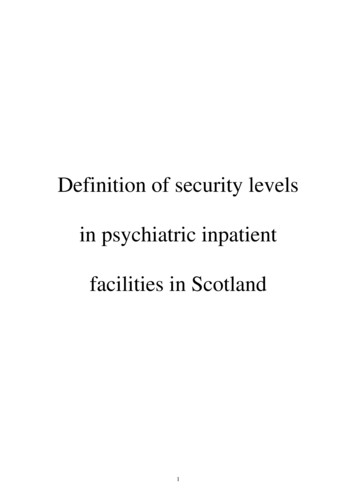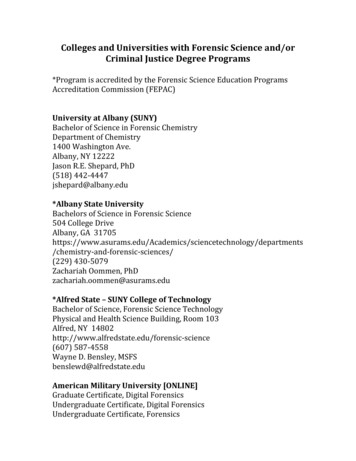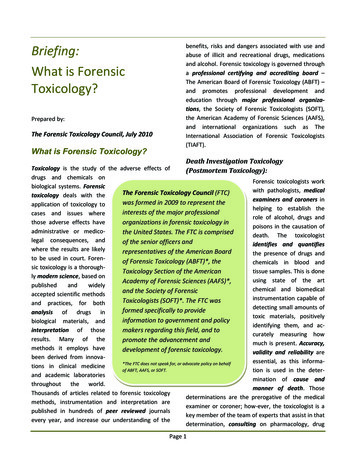
Transcription
Briefing:What is ForensicToxicology?Prepared by:The Forensic Toxicology Council, July 2010What is Forensic Toxicology?benefits, risks and dangers associated with use andabuse of illicit and recreational drugs, medicationsand alcohol. Forensic toxicology is governed througha professional certifying and accrediting board –The American Board of Forensic Toxicology (ABFT) –and promotes professional development andeducation through major professional organiza‐tions, the Society of Forensic Toxicologists (SOFT),the American Academy of Forensic Sciences (AAFS),and international organizations such as TheInternational Association of Forensic Toxicologists(TIAFT).Death Investigation ToxicologyToxicology is the study of the adverse effects of(Postmortem Toxicology):drugs and chemicals onForensic toxicologists workbiological systems. Forensicwith pathologists, medicalThe Forensic Toxicology Council (FTC)toxicology deals with theexaminers and coroners inwas formed in 2009 to represent theapplication of toxicology tohelping to establish theinterests of the major professionalcases and issues whererole of alcohol, drugs andthose adverse effects haveorganizations in forensic toxicology inpoisons in the causation ofadministrative or medico‐the United States. The FTC is compriseddeath. The toxicologistlegal consequences, andof the senior officers andidentifies and quantifieswhere the results are likelyrepresentatives of the American Boardthe presence of drugs andto be used in court. Foren‐of Forensic Toxicology (ABFT)*, thechemicals in blood andsic toxicology is a thorough‐tissue samples. This is doneToxicology Section of the Americanly modern science, based onusing state of the artAcademy of Forensic Sciences (AAFS)*,publishedandwidelychemical and biomedicaland the Society of Forensicaccepted scientific methodsinstrumentationcapable ofToxicologists (SOFT)*. The FTC wasand practices, for bothdetecting small amounts offormed specifically to provideanalysis of drugs intoxic materials, positivelyinformation to government and policybiological materials, andidentifying them, and ac‐interpretation of thosemakers regarding this field, and tocurately measuring howresults. Many of thepromote the advancement andmuch is present. Accuracy,methods it employs havedevelopment of forensic toxicology.validity and reliability arebeen derived from innova‐essential, as this informa‐*The FTC does not speak for, or advocate policy on behalftions in clinical medicineof ABFT, AAFS, or SOFT.tion is used in the deter‐and academic laboratoriesmination of cause andthroughout the world.manner of death. ThoseThousands of articles related to forensic toxicologydeterminations are the prerogative of the medicalmethods, instrumentation and interpretation areexaminer or coroner; how‐ever, the toxicologist is apublished in hundreds of peer reviewed journalskey member of the team of experts that assist in thatevery year, and increase our understanding of thedetermination, consulting on pharmacology, drugPage 1
kinetics and interactions, metabolism, adverse andidiosyncratic reactions, drug tolerance, postmortemartifacts, drug stability, and other factors. Thepathologist considers this information in the contextof the investigative and medical history of the case,and the findings of disease or other medicalconditions at autopsy. Accurately establishing theappropriate cause and manner of death has seriousimplications for public health and public safety, andforensically reliable toxicology is an essentialcomponent of that process. Death Investigationtoxicology is performed by both public and privatelaboratories and many private forensic laboratoriesprovide specialized expertise and services notavailable in government laboratories.provides interpretation of the result with respect towhether the dose represents typical therapeutic use,recreational use, or potential abuse, and can provideopinions about the likely effects of these patterns ofuse. This can include performance enhancementwhich occurs following the use of stimulants, andimpairment from recreational or prescriptionmedication use and misuse. Forensic toxicologistsreview and testify in cases of impaired drivinginvolving alcohol and drugs, and address diverseissues such as transportation safety, drug facilitatedcrimes, competency, intoxication and diminishedcapacity. Forensic toxicologists frequently testify incourt to both their findings and to theirinterpretation. This type of testing may occur inpublic crime laboratories, but also may be a functionHuman Performance Toxicology:of a health department in some states. Many bloodalcohol and drug testingHuman Performance Tox‐cases are performed inicology deals with theThe four disciplines of Forensic Toxicology:accreditedprivate oreffects of alcohol andacademic forensic toxic‐drugs on human perform‐Death Investigation Toxicologyology laboratories thatance and behavior, and(Postmortem Toxicology)voluntarily observe thethe medico‐legal conse‐Human Performance Toxicologysame standards in placequences of drug andDopingControlin the public sector.alcohol use. This mayinclude investigations ofForensic Workplace Drug TestingAdditionally, most statesimpaired driving, vehic‐have thousands of al‐ular assault and homicide,cohol breath testing operators which function underdrug facilitated crimes including sexual assault, andcertification from a wide variety of state systems.aircraft, motor vehicle and maritime collisionAlcohol breath calibration laboratories are alsoinvestigations. Forensic toxicologists performbeginning to be accredited under ASCLD‐LAB and ISOanalysis of drugs and alcohol in biological samples,17025. Alcohol breath testing produces evidence intypically blood and urine, but increasingly in otherDUI and impairment cases but is also integral inmatrices such as oral fluid, and hair, for the purposesworkplace drug testing.of determining the timing, extent, and impairmentresulting from different patterns of drug and alcoholDoping Control:use. The toxicologist uses state‐of‐the‐art analyticalGoverning bodies of most competitive andmethods, such as are found in many research andintramural sports have derived rules regardinghospital laboratories to isolate drugs from complexperformance enhancing drug use to protect thebiological samples, prepare them for analysishealth and welfare of the amateur and professionalthrough extraction and purification, then determineathletes, to maintain a fair and even competitivethe identity and amount of drug present. Followingstandard, and avoid wagering fraud. This applies tothe analytical phase, the forensic toxicologistPage 2
both human and animal sports. International groupssuch as the International Olympic Committee (IOC),the World Anti‐Doping Agency (WADA), and theInternational Federation of Horseracing Authorities(IFHA) work to update and maintain these lists aspatterns of drug use change. Enforcing these rulesrequires periodic off‐season random and event‐focused drug testing for performance enhancingdrugs, and other medications that appear on theorganizations prohibited substances lists. Forensictoxicologists in this field use many of the same highperformance analytical methods to detect currentand historical use of banned substances, includingstimulants, anabolic steroids, and diuretics. This typeof testing occurs in commercial and public accreditedlaboratories around the world, though there is alsotesting of high‐school, college and other athletesthat occurs in private laboratories.Forensic Workplace Drug Testing:Use of drugs by people in the workplace hassignificant safety and economic consequences.Consequently, in the United States, workers in safetysensitive positions are prohibited from using rec‐reational drugs or taking certain medications withouta prescription. Enforcing these standards requirespre‐employment, random, and for‐cause drugtesting, such as following an accident or a trans‐portation collision. Members of the US military,employees working for the Federal Government, ortheir contractors are also required to comply withthese standards set forth in the Drug‐Free WorkplaceAct adopted by Congress in 1988. Forensic toxic‐ologists perform testing of urine samples in theselaboratories regulated and inspected on behalf ofthe Federal Government in a program managed bythe Substance Abuse and Mental Health ServicesAdministration (SAMHSA). Testing for five majorclasses of abused drugs and their metabolites, thesescientists employ highly uniform and well‐definedtechniques and methods to minimize the risk oferrors, and ensure that employees are treated fairlyand that testing is done to the highest forensicstandards. The majority of workplace drug testing isnot covered directly by accreditation programshowever. These unregulated programs can performtests using other matrices such as oral fluid, sweatand hair.A related subset of workplace testing is for paroleand probation both at the state and federal levels.This testing is often conducted with methods similarto workplace samples but is applicable to thecriminal system in the management of parolees.Outside of the military, almost all of this testingoccurs in commercial laboratories.Promoting Scientific Excellenceand Professional Standards inForensic ToxicologyIn 2009, the FTC established a scientific workinggroup in forensic toxicology (SWGTOX) to organizeefforts to advance and standardize the practice offorensic toxicology in US laboratories. The activitiesof SWGTOX are discussed below. The FTC receivedfunding support from the National Institute of justice(NIJ) to launch SWGTOX which had its inauguralworkgroup meetings in February 2009.SOFT and the AAFS Toxicology Section developed aguidance document in the 1990’s to identify goodpractices in forensic toxicology related to qualitycontrol and quality assurance, method selection andoperation, instrument and equipment maintenance,staff qualifications and training, documentation ofresults, and laboratory management and safety.These guidelines became the basis for the develop‐The SOFT/AAFS Laboratory Guidelines are available at:http://www.soft‐tox.org/?pn publications&sp Laboratory GuidelinesPage 3
ment of a laboratory accreditation program imple‐mented by ABFT in 1996. Currently 26 forensictoxicology laboratories are accredited.and regulations already exist (e.g., Federal Drug‐FreeWorkplace Program and the World Anti‐DopingAgency).The National Laboratory Certification Program(NLCP) currently accredits 38 regulated workplacelaboratories. These laboratories are inspected andevaluated under federal guidelines. Again theseguidelines address good practices for forensictoxicology and quality control and assurance.These committees conduct business through estab‐lished subcommittees and task groups to focus onspecific aspects of the SWGTOX mission. Theobjectives of the SWGTOX are to establish minimumstandards for the practice of forensic toxicology inthe following areas 1) Standards, practice, protocolsincluding quality assurance and quality control, ry compliance with standards of practice),and 4) Certification (individual compliance witheducational and experience standard to practiceforensic toxicology). SWGTOX will also establish auniform Code of Ethics for forensic toxicologists,identify areas of research and development in thefield of forensic toxicology, and promote publicawareness of the field of forensic toxicology throughoutreach.The SOFT/AAFS Laboratory Guidelines committeehas continued to review and update the guidelines,and the most recent version was updated in 2006.ABFT continues to work with the SOFT/AAFS com‐mittee in its revisions to the ABFT inspectionchecklist to account for developments in technology,instrumentation and standards of practice.In 2009, ABFT began the process of aligning its lab‐oratory accreditation program with ISO/IEC stand‐ards. Both ISO 17025 (Testing and CalibrationLaboratories), and ISO 15189 (Clinical Laboratories)were evaluated, and ABFT is pursuing ISO 15189 as atemplate for this ISO accreditation.SWGTOX –www.SWGTOX.orgWhat professional groupsrepresent Forensic Toxicology?The American Academy of Forensic Sciences(AAFS) – Toxicology Section –www.aafs.orgSWGTOX was constit‐AAFS is a multi‐The three committees of SWG‐Tox:uted by the FTC indisciplinary organizationOctober 2009, at resenting forensicannual SOFT meetingsciences in the Unitedin Oklahoma City. TheEducation, Ethics, Outreach and CertificationStates.AAFS has overmissionoftheResearch, Development, Testing and Evaluation6000 members who areSWGTOX is to investi‐engaged in the practicegate, analyze, developof forensic science or in training in this field. AAFSand disseminate consensus in standards of practicepromotes professional development, research,for forensic toxicology. The scope of SWGTOXsharing of information, professional networking, andactivities includes post‐mortem and human perfor‐recognition of leadership and service in the forensicmance toxicology. While the standards developed bysciencecommunity. AAFS publishes a peer‐reviewedSWGTOX are considered good standard practice in allJournal – the Journal of Forensic Sciences. The AAFSforensic toxicology disciplines, the scope of SWGTOXToxicology Section provides training and educationactivities does not necessarily include thoseactivities for its members, governs committeesspecialized areas where mandated, codified rulesPage 4
dedicated to the advancement of forensic toxicologysub‐disciplines and promotes the advancement ofknowledge in the field.The American Board of Forensic Toxicology(ABFT) –www.abft.orgEstablished in1975 as a pro‐fessional certi‐fication Boardfor the disci‐pline of forensictoxicology, ABFT certifies appropriately qualifyiedindividuals as professional toxicologists. The criteriafor certification are education, experience, successfulcompletion of an examination, and documentedcontinuing professional education. Certification isawarded at the Diplomate (PhD) level and ForensicToxicology Specialist (non‐PhD) level. Currently thereare 220 Board certified forensic toxicologists in theUnited States and internationally. ABFT maintainsand enforces a code of ethics for its certificants.ABFT also offers accreditation to forensic toxicologylaboratories, based on compliance with acomprehensive checklist, participation in proficiencytesting programs, and on‐site inspections and re‐inspections. ABFT is accredited by the ForensicSpecialties Accreditation Board (FSAB).Society of Forensic Toxicologists (SOFT) –www.soft‐tox.orgleading developments in the field. SOFT alsomaintains committees charged with the develop‐ment of standards for analytical toxicology laborat‐ories, which collaborates with ABFT and AAFS. SOFTand AAFS have jointly prepared a document onLaboratory Guidelines designed to promote consist‐ent minimum standards of practice. These guidelinesbecame the basis for the ABFT Laboratory Accredita‐tion checklist.Forensic Toxicology Council (FTC) –The FTC was formed in 2009 to coordinate theefforts of the leadership of the three organizationsdescribed above, to ensure consistency in plans forprofessional development of the field, a unified voicefor forensic toxicology on matters related to legisla‐tive or regulatory action governing forensic toxic‐ology laboratories, and to manage projects thatrequire the joint efforts of the three organizationsspecifically the development of a SWGTOX. The FTCmembership is comprised of the ranking officers ofSOFT, ABFT and the AAFS Toxicology section alongwith the representatives of SOFT and ABFT to theConsortium of Forensic Science Organizations(CFSO).Other –Various regional forensic science and forensic toxic‐ology groups exist around the United States, andhave local meetings and trainings. The membershipof these regional groups overlaps significantly withthe above organizations.SOFT is a professionalmembership organizationfor forensic toxicologyprofessionals with morethan 900 members. It holdsan annual meeting for thepresentation of researchand case reports, new anal‐ytical methods and data analysis. Its abstracts arepeer reviewed. SOFT publishes annually a specialissue of the Journal of Analytical Toxicology featuringPage 5
Volume of samples (Monthly workload)Forensic Toxicology StatisticsSOFT recently surveyed the toxicology community tobetter understand the nature of the profession.These figures represent preliminary results of theseefforts.Self reported type of laboratoryLaboratories were asked how they would character‐ize their laboratory. It should be noted that manylaboratories handle multiple types of work. This is asa percentage of laboratories not as a percentage ofthe work.8%28%It is very difficult to get accurate numbers thatreflect the total workload in toxicology due to thevariability in how cases and samples are counted.However, approximately 6.5 million workplace sam‐ples are tested under federal regulation and anadditional estimated 50 million non‐regulated work‐place samples are tested annually. Of the lab‐oratories responding, there is a broad distribution ofworkloads from only 1 case per month to the highestreporting 260,000 samples per month.Forensic drug testing28%Postmortem toxicologyHuman performance35%Independent consultantLaboratory AccreditationLess than 1% of responses indicated doping control.Funding or business model of laboratoryLaboratories were asked how they are funded.Again, laboratories may have multiple sources offunding. This also indicates 41% of toxicologylaboratories responding are other than publiclyfunded.County Funded4% 2% 3%Federally funded18%10%7%22%5%Only a few states (New York, Texas and Oklahoma)and Federal programs require laboratory accredita‐tion. Not all forensic toxicology laboratories areaccredited; however on a largely voluntary basisaccreditation is well established in the field under anumber of programs. Many laboratories participatein more than one program.27%State fundedCity or Municipality fundedCommercially fundedHospital not for profitUniverity not for profitIndependent not for profitOtherPage 6Percentage of laboratories reporting participation inaccreditation programs24%American Board of Forensic Toxicology (ABFT)15%ISO 170251%ISO 151890%ISO 17011National Laboratory Certification Program (NLCP) 20%18%ASCLD‐LAB (legacy)21%CLIA30%College of American Pathologists (CAP)State programs (including alcohol accreditations) 22%3%Department of Defense (military drug screening)12%No accreditation
Contact InformationAdditional information can be obtained frommembers of the FTC, SWGTOX, and their relatedorganizations by contacting:Officers:Barry K Logan, PhD, DABFT (Chair)AAFS Vice PresidentNMS Labs3701 Welsh RoadWillow Grove, PA 18901(267) 615‐3516barry.logan@nmslabs.comBruce A Goldberger, PhD, DABFT (Secretary)ABFT Vice PresidentDept of Pathology, Immunology & Laboratory MedicineUniversity of Florida College of Medicine4800 S.W. 35th DriveGainesville, FL 32608(352) 265‐0680 x72001goldbeba@pathology.ufl.eduMembers:Yale H Caplan PhD, DABFTABFT representative to CFSONational Scientific Services3411 Phillips DriveBaltimore, MD 21208(410) 486‐7486fortox@aol.comKenneth E Ferslew PhD, DABFTAAFS Toxicology Section ChairEast Tennessee State UniversityToxicology Section, Box 70422Johnson City, TN 37614(423) 439‐6424ferslew@etsu.eduBradford R Helper, PhD, DABFTSOFT PresidentWayne County Medical Examiner’s Office1300 East Warren AvenueDetroit, MI 48207(313) 833‐2552bhepler@co.wayne.mi.usPhilip Kemp, PhD, DABFTAAFS Toxicology Section SecretaryARLOK Laboratories840 Research Parkway, Suite. 546Oklahoma City, OK 73104(405) 271‐1144pkemp@arlok.comSarah Kerrigan, PhDSOFT Vice PresidentSam Houston Regional Crime Laboratory8301 New Trails Drive, Suite 125The Woodlands, TX 77381(936) 294‐2503sarah.kerrigan@shsu.eduMarina Stajic, PhD, DABFTABFT PresidentOffice of Chief Medical Examiner520 First AvenueNew York, NY 10016(212) 447‐2637MStajic@ocme.nyc.govPeter R Stout PhD, DABFTSOFT representative to CFSORTI International3040 Cornwallis RoadPO Box 12194Research Triangle Park, NC 27709(919) 316 3450pstout@rti.orgSWGTOX Co‐Chairs:Daniel S Isenschmid, PhD, DABFTWayne County Medical Examiner’s Office1300 East Warren AvenueDetroit, MI 48207(313) 833‐2552Disensch@co.wayne.mi.usRobert A Middleberg PhD, DABFTNMS Labs3701 Welsh RoadWillow Grove, PA 18901(267) 615‐3516robert.middleberg@nmslabs.comBruce A Goldberger, PhD, DABFTPage 7
of forensic science or in training in this field. AAFS promotes professional development, research, sharing of information, professional networking, and recognition of leadership and service in the forensic science community. AAFS publishes a peer‐reviewed Journal – th
